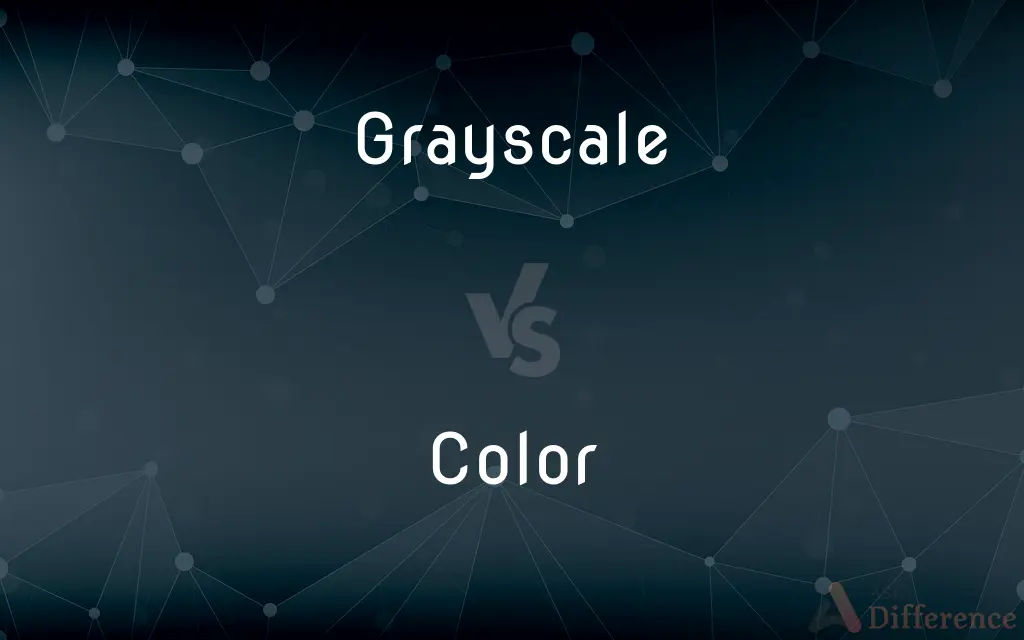Grayscale vs. Color — What's the Difference?
By Urooj Arif & Fiza Rafique — Updated on April 20, 2024
Grayscale images use shades of gray without color, emphasizing contrast and texture, while color images utilize a full spectrum of colors, providing detailed and realistic representations.

Difference Between Grayscale and Color
Table of Contents
ADVERTISEMENT
Key Differences
Grayscale, often referred to as black and white, comprises various shades of gray, depicting images using intensities of light but no hues. On the other hand, color images use combinations of red, green, and blue (RGB) light to produce a broad array of colors, capturing the vibrant and dynamic qualities of the visual world.
In grayscale images, the focus shifts towards texture, shape, and contrast, making them useful for certain types of analysis and artistic expression where color may be a distraction. Color images, however, are crucial for displaying natural scenes and are more engaging for most viewers, offering a more realistic portrayal of life.
The use of grayscale can simplify the process of printing and reduce costs, as it requires only a single ink or tonal layer. Whereas, color printing involves multiple layers and inks, increasing complexity and expense, but is essential for marketing, branding, and visual appeal.
Grayscale images are often used in technical fields such as radiology, where varying shades of gray translate well to different densities and materials in scans. Color is vital in fields like geographic information systems (GIS) and botany, where color differentiation is necessary for identification and analysis.
Photographers and artists might choose grayscale to convey a sense of timelessness or focus on raw emotional expression, stripping away the distraction of color. Color photography, by contrast, is used to capture the full vibrancy and detail of a scene, often making it more relatable and evocative to the viewer.
ADVERTISEMENT
Comparison Chart
Definition
Uses shades of gray without color.
Utilizes the full spectrum of colors.
Key Focus
Contrast, texture, and light intensity.
Realistic portrayal, vibrancy, and detail.
Printing
Simpler, uses less ink.
More complex, uses multiple inks.
Typical Use
Artistic photography, technical imaging.
Everyday photography, marketing.
Visual Impact
Timeless, emphasizes form and light.
Engaging, depicts natural scenes vividly.
Compare with Definitions
Grayscale
Preferred in certain artistic and print media for its simplicity and cost-effectiveness.
Grayscale printing is often used for newspaper photos to reduce printing costs.
Color
Images that include the full color spectrum, offering more realistic and detailed representations.
Color photography is essential for capturing the vivid hues of a sunset.
Grayscale
An image created using shades of gray only, from black to white.
The artist chose a grayscale palette to enhance the dramatic lighting in the photograph.
Color
Requires more complex technology for both capture and display.
Color printing requires cyan, magenta, yellow, and black inks for accurate reproduction.
Grayscale
Common in settings where color does not add informational value.
Most X-rays are viewed in grayscale to better assess bone and tissue density.
Color
Often used to make educational material more accessible and understandable.
Color-coded maps in textbooks help students easily differentiate geographic features.
Grayscale
Can convey a stronger emotional or nostalgic impact.
Grayscale film noir uses shadow and light to create a mysterious, old-time feel.
Color
Essential in fields requiring precise color differentiation.
In botany, accurate color images are crucial for identifying plant species.
Grayscale
Emphasizes light, shadow, and textures without the influence of color.
Grayscale photography is used in fashion to focus on texture and pattern details.
Color
Adds significant visual appeal and can affect emotional responses.
Advertisements use color images to attract and engage viewers effectively.
Grayscale
In digital photography, computer-generated imagery, and colourimetry, a greyscale image is one in which the value of each pixel is a single sample representing only an amount of light; that is, it carries only intensity information. Greyscale images, a kind of black-and-white or grey monochrome, are composed exclusively of shades of grey.
Color
Color (American English), or colour (Commonwealth English), is the characteristic of visual perception described through color categories, with names such as red, orange, yellow, green, blue, or purple. This perception of color derives from the stimulation of photoreceptor cells (in particular cone cells in the human eye and other vertebrate eyes) by electromagnetic radiation (in the visible spectrum in the case of humans).
Grayscale
A series of shades ranging from pure white to pure black, used in displaying monochromatic images.
Color
The appearance of objects or light sources described in terms of the individual's perception of them, involving hue, lightness, and saturation for objects, and hue, brightness, and saturation for light sources.
Grayscale
An image displayed using such a series of shades.
Color
The characteristics of light by which the individual is made aware of objects or light sources through the receptors of the eye, described in terms of dominant wavelength, luminance, and purity.
Grayscale
(photography) A printed strip of graduated tones used to check exposure and development times.
Color
A gradation or variation of this aspect, especially when other than black, white, or gray; a hue:fireworks that exploded in brilliant colors.
Grayscale
(imaging) The use of black and white, representing color with shades of gray.
Color
A substance, such as a dye, pigment, or paint, that imparts a hue.
Grayscale
(imaging) Black and white, representing color with shades of gray.
Color
The use of different colors in visual representation.
Grayscale
(transitive) To convert to grayscale.
Color
The different colors used in visual representation:one of the earliest movies in color.
Color
The general appearance of the skin, especially as an indication of good health
Regained her color after a few days' rest.
Color
A reddening of the face, as a blush or sign of anger.
Color
Skin pigmentation considered as a racial characteristic or a marker of racial identity, especially when other than white:"My father told me if I go west, there's integration; you don't worry about color"(Itabari Njeri). See Usage Note at person of color.
Color
A colored item, such as a badge, ribbon, or piece of clothing, serving as an identifying mark:wore the colors of their college.
Color
A flag or banner, as of a country or military unit:a ship flying the colors of Brazil.
Color
The salute made during the ceremony of raising or lowering a flag.
Color
ColorsOne's opinion or position:Stick to your colors.
Color
OftencolorsCharacter or nature:revealed their true colors.
Color
An outward and often deceptive appearance:a tale with the merest color of truth.
Color
Appearance of authenticity:testimony that lends color to an otherwise absurd notion.
Color
(Law)The appearance of a legal claim, as to a right or office.
Color
Vividness or variety in expression:a story told with a lot of color.
Color
Commentary distinguished by vivid details or background information, as during a sports broadcast:A former coach provided the color for the championship game.
Color
Local color.
Color
The use or effect of pigment in painting, as distinct from form.
Color
(Music)Quality of tone or timbre.
Color
A particle or bit of gold found in auriferous gravel or sand.
Color
(Physics)See color charge.
Color
(Astronomy)See color index.
Color
To impart color to or change the color of.
Color
To give a distinctive character or quality to; modify:"Both books are colored by the author's childhood experiences"(Deborah M. Locke).
Color
To exert an influence on; affect:The war colored the soldier's life.
Color
To misrepresent, especially by distortion or exaggeration:color the facts.
Color
To gloss over; excuse:a parent who colored the children's lies.
Color
To take on color.
Color
To change color.
Color
To become red in the face; redden or blush.
Color
(uncountable) The spectral composition of visible light.
Humans and birds can perceive color.
Color
A subset thereof:
Color
(countable) A particular set of visible spectral compositions, perceived or named as a class.
Most languages have names for the colors black, white, red, and green.
Color
(uncountable) Hue as opposed to achromatic colors (black, white and grays).
He referred to the white flag as one "drained of all color".
Color
These hues as used in color television or films, color photographs, etc (as opposed to the shades of grey used in black-and-white television).
This film is broadcast in color.
Most people dream in color, but some dream in black and white.
Color
(heraldry) Any of the standard dark tinctures used in a coat of arms, including azure, gules, sable, and vert.
Color
A paint.
The artist took out her colors and began work on a landscape.
Color
(uncountable) Human skin tone, especially as an indicator of race or ethnicity.
Color has been a sensitive issue in many societies.
Color
(medicine) Skin color, noted as normal, jaundiced, cyanotic, flush, mottled, pale, or ashen as part of the skin signs assessment.
Color
(figuratively) Richness of expression; detail or flavour that is likely to generate interest or enjoyment.
There is a great deal of colour in his writing.
A bit of local color
Could you give me some color with regards to which products made up the mix of revenue for this quarter?
Color
A standard, flag, or insignia:
Color
(in the plural) A standard or banner.
The loss of their colors destroyed the regiment's morale.
Color
(in the plural) The flag of a nation or team.
The colors were raised over the new territory.
Color
(in the plural) Gang insignia.
Both of the perpetrators were wearing colors.
Color
(in the plural) An award for sporting achievement, particularly within a school or university.
He was awarded colors for his football.
Color
The morning ceremony of raising the flag.
Color
(physics) A property of quarks, with three values called red, green, and blue, which they can exchange by passing gluons; color charge.
Color
A third-order measure of derivative price sensitivity, expressed as the rate of change of gamma with respect to time, or equivalently the rate of change of charm with respect to changes in the underlying asset price.
Color
(typography) The relative lightness or darkness of a mass of written or printed text on a page. (See type color)
Color
(snooker) Any of the colored balls excluding the reds.
Color
A front or facade; an ostensible truth actually false; pretext.
Color
An appearance of right or authority; color of law.
Under color of law, he managed to bilk taxpayers of millions of dollars.
Color
Conveying color, as opposed to shades of gray.
Color television and movies were considered a great improvement over black and white.
Color
(transitive) To give something color.
We could color the walls red.
Color
(transitive) To cause (a pipe, especially a meerschaum) to take on a brown or black color, by smoking.
Color
(intransitive) To apply colors to the areas within the boundaries of a line drawing using colored markers or crayons.
My kindergartener loves to color.
Color
To affect without completely changing.
That interpretation certainly colors my perception of the book.
Color
(informal) To attribute a quality to; to portray (as).
Color me confused.
They tried to colour the industrial unrest as a merely local matter.
Color
To assign colors to the vertices of a graph (or the regions of a map) so that no two vertices connected by an edge (regions sharing a border) have the same color.
Can this graph be 2-colored?
You can color any map with four colors.
Color
A property depending on the relations of light to the eye, by which individual and specific differences in the hues and tints of objects are apprehended in vision; as, gay colors; sad colors, etc.
Color
Any hue distinguished from white or black.
Color
The hue or color characteristic of good health and spirits; ruddy complexion.
Give color to my pale cheek.
Color
That which is used to give color; a paint; a pigment; as, oil colors or water colors.
Color
Shade or variety of character; kind; species.
Boys and women are for the most part cattle of this color.
Color
A distinguishing badge, as a flag or similar symbol (usually in the plural); as, the colors or color of a ship or regiment; the colors of a race horse (that is, of the cap and jacket worn by the jockey).
In the United States each regiment of infantry and artillery has two colors, one national and one regimental.
Color
An apparent right; as where the defendant in trespass gave to the plaintiff an appearance of title, by stating his title specially, thus removing the cause from the jury to the court.
Color
To change or alter the hue or tint of, by dyeing, staining, painting, etc.; to dye; to tinge; to paint; to stain.
The rays, to speak properly, are not colored; in them there is nothing else than a certain power and disposition to stir up a sensation of this or that color.
Color
To change or alter, as if by dyeing or painting; to give a false appearance to; usually, to give a specious appearance to; to cause to appear attractive; to make plausible; to palliate or excuse; as, the facts were colored by his prejudices.
He colors the falsehood of Æneas by an express command from Jupiter to forsake the queen.
Color
To hide.
That by his fellowship he color mightBoth his estate and love from skill of any wight.
Color
To acquire color; to turn red, especially in the face; to blush.
Color
A visual attribute of things that results from the light they emit or transmit or reflect;
A white color is made up of many different wavelengths of light
Color
Interest and variety and intensity;
The Puritan Period was lacking in color
Color
The timbre of a musical sound;
The recording fails to capture the true color of the original music
Color
A race with skin pigmentation different from the white race (especially Blacks)
Color
An outward or token appearance or form that is deliberately misleading;
He hoped his claims would have a semblance of authenticity
He tried to give his falsehood the gloss of moral sanction
The situation soon took on a different color
Color
Any material used for its color;
She used a different color for the trim
Color
(physics) the characteristic of quarks that determines their role in the strong interaction; each flavor of quarks comes in three colors
Color
The appearance of objects (or light sources) described in terms of a person's perception of their hue and lightness (or brightness) and saturation
Color
Add color to;
The child colored the drawings
Fall colored the trees
Colorize black and white film
Color
Affect as in thought or feeling;
My personal feelings color my judgment in this case
The sadness tinged his life
Color
Modify or bias;
His political ideas color his lectures
Color
Decorate with colors;
Color the walls with paint in warm tones
Color
Gloss or excuse;
Color a lie
Color
Change color, often in an undesired manner;
The shirts discolored
Color
Having or capable of producing colors;
Color film
He rented a color television
Marvelous color illustrations
Black-and-white film
A black-and-white TV
The movie was in black and white
Common Curiosities
What are the advantages of using color in images?
Color images provide a more realistic and relatable view, are better for depicting natural scenes, and are more engaging for most applications.
How do printing costs compare between grayscale and color images?
Printing costs for grayscale images are generally lower since they use less ink and simpler processes compared to color printing, which requires multiple layers of colored inks.
Why might someone choose to use grayscale images instead of color?
Someone might choose grayscale to reduce distractions, focus on structural details, or for certain artistic effects.
How does grayscale enhance certain visual aspects of an image?
Grayscale enhances visual aspects by focusing on light intensity, shadows, and textures, which can help in emphasizing depth and detail.
Can the use of grayscale affect the perception of depth in an image?
Yes, grayscale can affect the perception of depth by emphasizing light contrasts and textural details, which can give a different sense of depth compared to color images.
What role does viewer perception play in the effectiveness of grayscale versus color images?
Viewer perception plays a crucial role; color images are often perceived as more modern and realistic, enhancing emotional and aesthetic responses. Grayscale images may invoke nostalgia or focus the viewer’s attention more on composition and form, influencing how the content is received and interpreted.
Is there a difference in the file size between grayscale and color images?
Yes, grayscale images generally have smaller file sizes because they contain less color information compared to color images, which require data for multiple color channels.
How does the choice between grayscale and color impact marketing materials?
The choice impacts marketing materials significantly; color images tend to attract more attention and are better remembered, making them more effective for engaging potential customers, while grayscale can convey sophistication and focus on product details.
Can grayscale images be converted to color and vice versa?
Yes, grayscale images can be colorized though the process can be complex, involving manual color mapping or automated AI technologies. Conversely, color images can easily be converted to grayscale, usually through digital software by removing color saturation.
What are the practical applications of grayscale imaging in medical diagnostics?
Grayscale imaging is extensively used in medical diagnostics, particularly in modalities like X-ray, MRI, and ultrasound, where different shades of gray effectively differentiate between various tissues, bones, and fluids.
Share Your Discovery

Previous Comparison
Great vs. Best
Next Comparison
Poll vs. PoolAuthor Spotlight
Written by
Urooj ArifUrooj is a skilled content writer at Ask Difference, known for her exceptional ability to simplify complex topics into engaging and informative content. With a passion for research and a flair for clear, concise writing, she consistently delivers articles that resonate with our diverse audience.
Co-written by
Fiza RafiqueFiza Rafique is a skilled content writer at AskDifference.com, where she meticulously refines and enhances written pieces. Drawing from her vast editorial expertise, Fiza ensures clarity, accuracy, and precision in every article. Passionate about language, she continually seeks to elevate the quality of content for readers worldwide.
















































